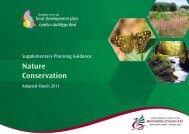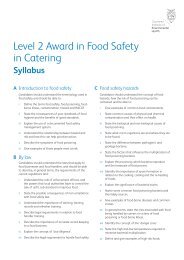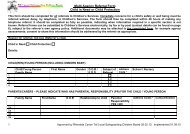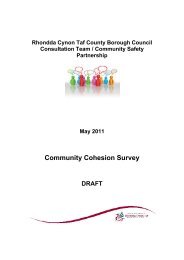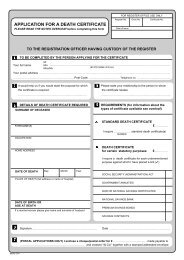Create successful ePaper yourself
Turn your PDF publications into a flip-book with our unique Google optimized e-Paper software.
<strong>Wasps</strong>The Council offers a service to get rid of wasps, but the following providessome advice.What are wasps?They are social insects that live together in colonies and form self-containedcommunities. In each community there are three castes, namely queens,males and workers.The only wasps that survive the winter are young fertilised queens. Theyemerge from hibernation in the spring and construct a new nest. This could bein a hole in the ground or inside a hollow tree. The queen lays 10-20 eggsinitially and when they hatch into larvae she feeds them until they emerge asworkers. At this stage, the queen wasp concentrates on egg laying and thenew workers forage for food, feed the young and enlarge and defend the nest.By the end of the season nests may contain thousands of workers. In latesummer, the colony produces males and new queens. They fly away and aftermating the queens find a place to hibernate. The cold weather eventually killsthe males, the workers and the foundation queen.Two species of wasp are found locally - ‘common wasps’ and ‘German wasps’- and are best known for their sting. While they have some beneficialcharacteristics, e.g. controlling other insect pests and clearing dead insectcarcases, their significant nuisance value means they may need to becontrolled. However, if they are not causing a nuisance they are best leftalone.Where can they be found?These insects are common throughout Europe. Their nests can normally befound in holes in the ground or inside hollow trees. Unfortunately, wasps feelequally at home in your garden shed and the cavity walls, eaves or roof spaceof your house.What do they eat?All wasps feed their young on meat (insect larvae, scraps of carrion etc.). Thewings of the prey are cut off by the workers powerful mouthparts and theremains are divided up and chewed into round food balls which are carriedhome to the larvae. The workers themselves (these are females withunderdeveloped reproductive organs) feed on liquid food.
Although wasps are fond of sweet things, they don't have the nectar suckingmouth parts of bees, but they do have very powerful jaws and a short tongue.Even so they can be seen drinking nectar from flowers and the juices of ripefruit (Common wasps will also attempt to invade honey bee nests to steal theirhoney) and curiously enough they are also fed by the larvae. In exchange forfly flesh the larvae regurgitate a sugary liquid which the workers eagerly lickup. In addition to providing the workers with a form of energy this mutualfeeding also has a social function, for it serves to bind the colony together.Towards the end of the summer, when the larvae have reached maturity, theworkers turn their attention to fruit, jam and other sweet substances and this iswhen they become a nuisance.Are wasps harmful?The main thing that worries people about wasps is their sting. A wasp uses itssting for killing prey, but it can also use it very effectively for defending itself.The sting has associated glands which produce venom. A sting can be verypainful, but is normally not dangerous, as the amount of venom injected isvery small. In some cases, however, people do become ill after being stung.In very extreme cases people suffer ‘anaphylactic shock’ which can provefatal. A sting in the mouth or on the neck can be serious, as the ‘mucusepithelium’ may become very swollen, making it difficult for the victim tobreathe. An ordinary uncomplicated sting can be treated with ammonia oralcohol or cold poultices, followed by an antihistamine ointment. If the victimbecomes pale and feels unwell with giddiness and nausea it is advisable toseek medical advice immediately.Unlike bees, wasps are able to sting repeatedly. The venom of the waspcontains a pheromone which acts as an alarm causing other wasps tobecome more aggressive when a wasp has stung something or has beenkilled. So it is a bad idea to swat a wasp near its nest site or to attempt toremove the nest yourself.How to get rid of waspsIndividual wasps entering a dwelling can be dealt with by using a flying insectspray. However, dealing with a nest is a more difficult issue and while anumber of products are available on the market you must consider the risk ofbeing stung and also difficulties that may be encountered in accessing thenest.It is, therefore, recommended that you get an experienced person, such as aPest Control Officer, to treat the nest.Contact InformationTelephone: 01443 425777Fax: 01443 425301Minicom: 01443 425535Email: publichealthprojectsupport@rhondda-cynon-taff.gov.uk





